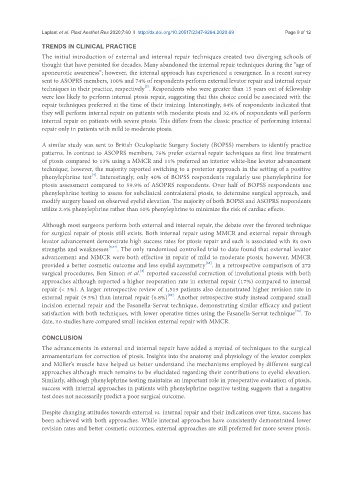Page 709 - Read Online
P. 709
Laplant et al. Plast Aesthet Res 2020;7:60 I http://dx.doi.org/10.20517/2347-9264.2020.69 Page 9 of 12
TRENDS IN CLINICAL PRACTICE
The initial introduction of external and internal repair techniques created two diverging schools of
thought that have persisted for decades. Many abandoned the internal repair techniques during the “age of
aponeurotic awareness”; however, the internal approach has experienced a resurgence. In a recent survey
sent to ASOPRS members, 100% and 74% of respondents perform external levator repair and internal repair
[5]
techniques in their practice, respectively . Respondents who were greater than 15 years out of fellowship
were less likely to perform internal ptosis repair, suggesting that this choice could be associated with the
repair techniques preferred at the time of their training. Interestingly, 84% of respondents indicated that
they will perform internal repair on patients with moderate ptosis and 32.4% of respondents will perform
internal repair on patients with severe ptosis. This differs from the classic practice of performing internal
repair only in patients with mild to moderate ptosis.
A similar study was sent to British Oculoplastic Surgery Society (BOPSS) members to identify practice
patterns. In contrast to ASOPRS members, 76% prefer external repair techniques as first line treatment
of ptosis compared to 13% using a MMCR and 11% preferred an interior white-line levator advancement
technique; however, the majority reported switching to a posterior approach in the setting of a positive
[4]
phenylephrine test . Interestingly, only 40% of BOPSS respondents regularly use phenylephrine for
ptosis assessment compared to 59.9% of ASOPRS respondents. Over half of BOPSS respondents use
phenylephrine testing to assess for subclinical contralateral ptosis, to determine surgical approach, and
modify surgery based on observed eyelid elevation. The majority of both BOPSS and ASOPRS respondents
utilize 2.5% phenylephrine rather than 10% phenylephrine to minimize the risk of cardiac effects.
Although most surgeons perform both external and internal repair, the debate over the favored technique
for surgical repair of ptosis still exists. Both internal repair using MMCR and external repair through
levator advancement demonstrate high success rates for ptosis repair and each is associated with its own
strengths and weaknesses [8,67] . The only randomized controlled trial to date found that external levator
advancement and MMCR were both effective in repair of mild to moderate ptosis; however, MMCR
[68]
provided a better cosmetic outcome and less eyelid asymmetry . In a retrospective comparison of 272
[8]
surgical procedures, Ben Simon et al. reported successful correction of involutional ptosis with both
approaches although reported a higher reoperation rate in external repair (17%) compared to internal
repair (< 3%). A larger retrospective review of 1,519 patients also demonstrated higher revision rate in
[69]
external repair (9.5%) than internal repair (6.8%) . Another retrospective study instead compared small
incision external repair and the Fasanella-Servat technique, demonstrating similar efficacy and patient
[70]
satisfaction with both techniques, with lower operative times using the Fasanella-Servat technique . To
date, no studies have compared small incision external repair with MMCR.
CONCLUSION
The advancements in external and internal repair have added a myriad of techniques to the surgical
armamentarium for correction of ptosis. Insights into the anatomy and physiology of the levator complex
and Müller’s muscle have helped us better understand the mechanisms employed by different surgical
approaches although much remains to be elucidated regarding their contributions to eyelid elevation.
Similarly, although phenylephrine testing maintains an important role in preoperative evaluation of ptosis,
success with internal approaches in patients with phenylephrine negative testing suggests that a negative
test does not necessarily predict a poor surgical outcome.
Despite changing attitudes towards external vs. internal repair and their indications over time, success has
been achieved with both approaches. While internal approaches have consistently demonstrated lower
revision rates and better cosmetic outcomes, external approaches are still preferred for more severe ptosis.

